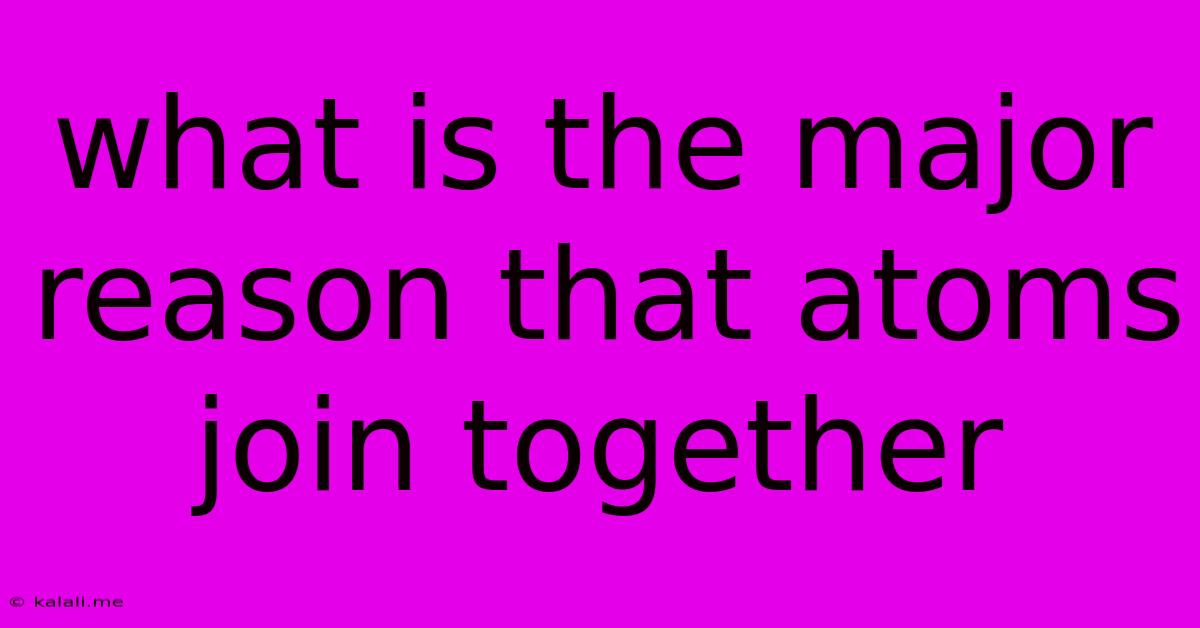What Is The Major Reason That Atoms Join Together
Kalali
May 24, 2025 · 3 min read

Table of Contents
What's the Major Reason Atoms Join Together? The Pursuit of Stability
Atoms, the fundamental building blocks of matter, don't exist in isolation in the vast majority of cases. They crave stability, and that desire drives them to bond with other atoms, forming molecules and compounds. This article delves into the core reason behind this atomic bonding, exploring the role of electron configuration and the resulting energetic stability. Understanding this fundamental principle is key to grasping the nature of chemistry and the world around us.
Atoms strive to achieve a stable electron configuration, usually resembling that of a noble gas. This is the major reason atoms join together. Noble gases, such as helium, neon, and argon, are exceptionally unreactive due to their full outermost electron shells (also known as valence shells). This stable arrangement, with eight electrons (octet rule, except for helium with two), represents the lowest energy state for these atoms. Other atoms, lacking this full valence shell, seek to attain it through chemical bonding.
The Octet Rule: A Guiding Principle
The octet rule, a simplification of a more complex reality, states that atoms tend to gain, lose, or share electrons to achieve a full set of eight electrons in their outermost shell. This drive for a complete octet is the primary motivator behind the formation of chemical bonds. Exceptions to the octet rule do exist, especially with atoms that can accommodate more than eight electrons in their valence shell, but it remains a valuable conceptual framework for understanding atomic bonding.
Types of Chemical Bonds: Achieving Stability Through Different Means
Atoms achieve stable electron configurations through several types of chemical bonds:
-
Ionic Bonds: These bonds form through the transfer of electrons from one atom to another. This transfer creates ions – atoms with a net electrical charge (cations, positive; anions, negative) – which are then held together by electrostatic attraction. For example, sodium (Na) readily loses one electron to become Na+, while chlorine (Cl) readily gains one electron to become Cl-. The electrostatic attraction between Na+ and Cl- forms the ionic compound sodium chloride (NaCl), or table salt.
-
Covalent Bonds: In covalent bonding, atoms share electrons to achieve a stable electron configuration. This sharing creates a strong bond between the atoms. For instance, two hydrogen atoms each share their single electron to form a hydrogen molecule (H₂), where each hydrogen atom effectively has two electrons in its valence shell, fulfilling the duet rule (a special case of the octet rule for hydrogen). This sharing results in a stable, lower-energy state.
-
Metallic Bonds: Metallic bonding occurs in metals. In this type of bonding, valence electrons are delocalized, meaning they're not associated with any specific atom but are free to move throughout the metal structure. This "sea" of electrons contributes to the characteristic properties of metals, such as electrical and thermal conductivity, malleability, and ductility.
Beyond the Octet Rule: A Deeper Look
While the octet rule provides a simplified understanding, the true driving force behind bond formation is the minimization of energy. Atoms bond to reach a lower energy state, more stable than their isolated individual states. This energy minimization is dictated by complex quantum mechanical interactions, but the concept of achieving a noble gas configuration remains a useful heuristic for predicting bonding behavior.
In conclusion, the primary reason atoms join together is their inherent drive to achieve a stable electron configuration, most often resembling that of a noble gas. This pursuit of stability leads to the formation of various types of chemical bonds, each characterized by unique electron interactions and resulting properties. Understanding this fundamental principle is crucial to unlocking the secrets of chemistry and the diverse materials that make up our world.
Latest Posts
Latest Posts
-
Explain Ending Of A Most Wanted Man
May 24, 2025
-
How To Prove A Function Is Onto
May 24, 2025
-
How To Get Power To An Outdoor Shed
May 24, 2025
-
Will A Gfci Work Without A Ground
May 24, 2025
-
I Am The Highway Lyrics Meaning
May 24, 2025
Related Post
Thank you for visiting our website which covers about What Is The Major Reason That Atoms Join Together . We hope the information provided has been useful to you. Feel free to contact us if you have any questions or need further assistance. See you next time and don't miss to bookmark.